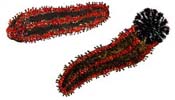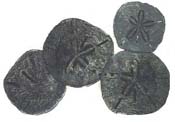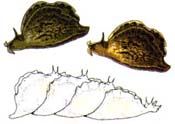 |
Redfish or Red Drum – Sciaenops ocellatus Redfish are easily recognized by their beautiful coppery color and one or more black spots at the base of their tail. The young feed in estuaries and bays, moving to deeper water when mature. They are especially fond of crabs and other crustaceans. Family: Sciaenidae/Drums |
 |
Red Footed Sea Cucumber – Pentacta pygmaea While most cucumbers burrow, this one has highly modified feet that are adapted to clinging. Often seen adhering to rocks and grass, they are found in high salinity, clear waters. Class: Holothuroidea |
 |
Sand Dollar – Mellita quinquiesperforata Their trails are visible on the beach at low tide, as they plow furrows in the sand while feeding on tiny particles of detritus. Food items are carried to their mouth on the underside of their body using thousands of tiny spines, moving them down channels. When they die, their spines disappear, leaving only the bleached white shell behind. Live specimens produce an antibiotic substance called "Echinochrome" which stains your fingers yellow. Class: Echinoidea |
 |
Sandy Sea Squirt – Molgula occidentalis These unsightly, lumpish brown sea squirts sometimes cover the bottoms of Alligator Harbor, St. Teresa and Carrabelle. They incorporate sand into their outer skins, possibly to hide from predatory starfish. Like all tunicates, their tadpole larvae have a forerunner of a backbone, making them among the most highly evolved of invertebrates. Subphylum: Urochordata Class: Ascidiacea |
 |
Sea Hare – Aplysia brasiliana A snail without a shell, it gracefully swims through the water column or moves across the bottom grazing on algae. It exudes a vivid purple ink when bothered. Sub-class: Opisthobranchia |
| « Previous | Next » |





